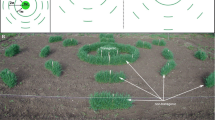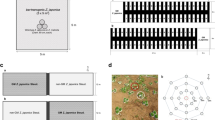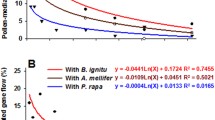Abstract
Bahiagrass (Paspalum notatum Flüggé) is the predominant forage grass in the southeastern US. The commercially important bahiagrass cultivar ‘Argentine’ is preferred for genetic transformation over sexual diploid cytotypes, since it produces uniform seed progeny through apomixis. Pseudogamous apomictic seed production in Argentine bahiagrass may contribute to transgene confinement. It is characterized by embryo development which is independent of fertilization of the egg cell, but requires fertilization with compatible pollen to produce the endosperm. Pollen-mediated gene transfer from transgenic, glufosinate-resistant apomictic bahiagrass as pollen donor at close proximity (0.5–3.5 m) with non-transgenic sexual or apomictic bahiagrass cultivars as pollen receptors was evaluated under field conditions. Hybridization frequency was evaluated by glufosinate herbicide resistance in >23,300 seedlings derived from open-pollinated (OP) pollen receptor plants. Average gene transfer between transgenic apomictic, tetraploid and sexual diploid bahiagrass was 0.03%. Herbicide-resistant hybrids confirmed by immuno-chromatographic detection of the PAT protein displayed a single copy bar gene identical to the pollen parent. Hybrids resulting from diploid pollen receptors were confirmed as triploids or aneu-triploids with significantly reduced vigor and seed set as compared to the parents. Transmission of transgenes to sexual bahiagrass is severely restricted by the ploidy difference between tetraploid apomicts and diploid sexual bahiagrass. Average gene transfer between transgenic apomictic tetraploid and non-transgenic, apomictic tetraploid bahiagrass was 0.17%, confirming a very low frequency of amphimixis in apomictic bahiagrass cultivars. While not providing complete transgene containment, gene transfer between transgenic apomictic and non-transgenic bahiagrass occurs at a much lower frequency than reported for other cross-pollinating or facultative apomictic grasses.






Similar content being viewed by others
References
Acuña CA (2006) Bahiagrass germplasm reproductive characterization, and breeding at the tetraploid level. MS Thesis, University of Florida, Gainesville, USA
Acuña CA, Blount AR, Quesenberry KH, Hanna WW, Kenworthy KE (2007) Reproductive characterization of bahiagrass germplasm. Crop Sci 47:1711–1717
Agharkar M, Lomba P, Altpeter F, Zhang H, Kenworthy K, Lange T (2007) Stable expression of AtGA2ox1 in a low-input turfgrass (Paspalum notatum Flüggé) reduces bioactive gibberellin levels and improves turf quality in field conditions. Plant Biotech J 5:791–801
Aguado-Santacruz GA, Rascόn-Cruz Q, Cabrera-Ponce JL, Martínez-Hernández A, Olalde-Portugal V, Herrera-Estrella L (2002) Transgenic plants of blue grama grass, Bouteloua gracilis (HBK) Lag. ex Steud., from microprojectile bombardment of highly chlorophyllous embryogenic cells. Theor Appl Genet 104:763–771
Altpeter F, James VA (2005) Genetic transformation of turf-type bahiagrass (Paspalum notatum Flüggé) by apomictic gene transfer. Intern Turfgrass Soc Res J 10:485–489
Bae TW, Vanjildorj E, Song SY, Nishiguchi S, Yang SS, Chandrashekhar T, Kang TW, Kim JI, Koh YJ, Lee J, Lee YE, Ryu KH, Lee HY, Park SY (2008) Environmental risk assessment of genetically engineered herbicide-tolerant Zoysia japonica. J Environ Qual 37:207–218
Bashaw EC, Funk CR (1987) Apomictic grasses. In: Fehr WR (ed) Principles of cultivar development, vol 2. Macmillan Publ. Co., New York, pp 40–82
Batra S, Kumar S (2003) Agrobacterium-mediated transient GUS gene expression in buffelgrass (Cenchrus ciliaris L.). J Appl Genet 44:449–458
Burson BL, Watson VH (1995) Bahiagrass, dallisgrass, and other Paspalum species. In: Barnes RF (ed) Forages: an introduction to grassland agriculture, 5th edn. 1. Iowa State University Press, Ames, pp 431–440
Burton GW (1942) Observations on the flowering habits of four Paspalum species. J Am Soc Agron 34:205–210
Burton GW (1946) Bahiagrass types. J Am Soc Agron 38:273–281
Burton GW (1948) The method of reproduction in common bahiagrass, Paspalum notatum. J Am Soc Agron 40:443–452
Burton GW, Forbes I (1960) The genetics and manipulation of obligate apomixis in common bahiagrass (Paspalum notatum Flüggé). In: Skilmore CL (ed) Proceedings international Grassland congress, 8th, Reading, England. 11–21 July 1960. Alden Press, Oxford, pp 66–71
Chambliss CG, Adjei MB (2006) Bahiagrass. EDIS SS-AGR-36
Chandler S, Dunwell JM (2008) Gene flow, risk assessment and the environmental release of transgenic plants. Crit Rev Plant Sci 27:25–49
Chapman MA, Burke JM (2006) Letting the gene out of the bottle: the population genetics of genetically modified crops. New Phytol 170:429–443
Cunliffe KV, Vecchies AC, Jones ES, Kearney GA, Forster JW, Spangenberg GC, Smith KF (2004) Assessment of gene flow using tetraploid genotypes of perennial ryegrass (Lolium perenne L.). Aust J Agric Res 55:389–396
Dalton SJ, Bettany AJE, Bhat V, Gupta MG, Bailey K, Timms E, Morris P (2003) Genetic transformation of Dichanthium annulatum (Forssk)—an apomictic tropical forage grass. Plant Cell Rep 21:974–980
Espinoza F, Pessino SC, Quarin CL, Valle EM (2002) Effect of pollination timing on the rate of apomictic reproduction revealed by RAPD markers in Paspalum notatum. Ann Bot 89:16–170
Forbes I, Burton GW (1961) Cytology of diploids, natural and induced tetraploids and intraspecific hybrids of bahiagrass, Paspalum notatum Flüggé. Crop Sci 1:402–406
Gao C, Jiang L, Folling M, Han L, Neilson KK (2006) Generation of large numbers of transgenic Kentucky bluegrass (Poa pratensis L.) plants following biolistic gene transfer. Plant Cell Rep 25:19–25
Gates RN, Quarin CL, Pedreira CGS (2004) Bahiagrass. In: Moser LE, Burson BL, Sollenberger LE (eds) Warm-Season (C4) grasses, Agronomy monograph no 45 s. ASA, CSSA, SSSA, Madison
Giddings GD, Sackville-Hamilton NR, Hayward MD (1997) The release of genetically modified grasses. Part 2: the influence of wind direction on pollen dispersal. Theor Appl Genet 94:1007–1014
Gould FW (1966) Chromosome numbers of some Mexican grasses. Can J Bot 44:1683–1696
Ha CD, Lemaux PG, Cho MJ (2001) Stable transformation of a recalcitrant Kentucky bluegrass (Poa pratensis L.) cultivar using mature seed-derived highly regenerative tissues. Vitro Cell Dev Biol Plant 47:6–11
Hanna W (1995) Use of apomixis in cultivar development. Adv Agron 54:333–350
Hanna WW, Burton GW (1986) Cytogenetics and breeding behavior of an apomictic triploid in bahiagrass. J Hered 77:457–459
Hoyle M, Hayter K, Cresswell JE (2007) Effect of pollinator abundance on self-fertilization and gene flow: application to GM canola. Ecol Appl 17:2123–2135
James VA, Neibaur I, Altpeter F (2008) Stress inducible expression of DREB1A transcription factor from xeric Hordeum spontaneum L. in turf and forage grass (Paspalum notatum Flüggé) enhances abiotic stress tolerance. Transgenic Res 17:93–104
Johnson PG, Larson SR, Anderton AL, Patterson JT, Cattani DJ, Nelson EK (2006) Pollen-mediated gene flow from Kentucky bluegrass under cultivated field conditions. Crop Sci 46:1990–1997
Johnston SA, Hanneman RE Jr (1995) The genetics of triploid formation and its relationship to endosperm balance number in potato. Genome 39:314–321
Johnston SA, den-Nijs TM, Peloquin SJ, Hanneman RE Jr (1980) The significance of genic balance to endosperm development in inter-specific crosses. Theor Appl Genet 57:5–9
Jorgensen RB, Hauser T, D’Hertefeldt T, Andersen NS, Hooftman D (2009) The variability of processes involved in transgene dispersal—case studies from Brassica and related genera. Environ Sci Pollut Res 16:389–395
Koltunow AM (1993) Apomixis: embryo sacs and embryos formed without meiosis or fertilization in ovules. Plant Cell 5:1425–1437
Koltunow AM, Bicknell RA, Chaudhury AM (1995) Apomixis—molecular strategies for the generation of genetically identical seeds without fertilization. Plant Physiol 108:1345–1352
Kumar J, Shukla SM, Bhat V, Gupta S, Gupta MG (2005) In vitro plant regeneration and genetic transformation of Dichanthium annulatum. DNA Cell Biol 24:670–679
Martínez EJ, Hopp HE, Stein J, Ortiz JPA, Quarin CL (2003) Genetic characterization of apospory in tetraploid Paspalum notatum based on the identification of linked molecular markers. Mol Breed 12:319–327
Messeguer J, Fogher C, Guiderdoni E, Marfa V, Catala MM, Bald G, Mele E (2001) Field assessments of gene flow form transgenic to cultivated rice (Oryza sativa L.) using herbicide resistance gene as tracer marker. Theor Appl Genet 103:1151–1159
Messeguer J, Marfa V, Catala MM, Guideroni E, Mele E (2004) A field study of pollen-mediate gene flow from Mediterranean GM rice to conventional rice and the red rice weed. Mol Breed 13:103–112
Messeguer J, Penas G, Ballester J, Bas M, Serra J, Salvia J, Palaudelmas M, Mele E (2006) Pollen-mediated gene flow in maize in real situations of coexistence. Plant Biotech J 4:633–645
Murray MG, Thompson WF (1980) Rapid isolation of high molecular-weight plant DNA. Nucleic Acids Res 8:4321–4325
Norrmann GA, Bovo OA, Quarin CL (1994) Post-zygotic seed abortion in sexual diploid x apomictic tetraploid intraspecific Paspalum crosses. Aust J Bot 42:449–456
Pozzobon MT, Valls JFM (1997) Chromosome number in germplasm accessions of Paspalum notatum (Gramineae). Braz J Genet 20:29–34
Quarin CL (1999) Effect of pollen source and pollen ploidy on endosperm formation and seed set in pseudogamous apomictic Paspalum notatum. Sex Plant Reprod 11:331–335
Quarin CL, Burson BL, Burton GW (1984) Cytology on intra- and inter-specific hybrids between two cytotypes of Paspalum notatum and P. Cromyorrhizon. Bot Gaz 145:420–426
Quarin CL, Espinoza F, Martínez EJ, Pessino SC, Bovo OA (2001) A rise of ploidy level induces the expression of apomixis in Paspalum notatum. Sex Plant Reprod 13:243–249
Rong J, Lu BR, Sing Z, Su J, Snow AA, Zhang X, Sun S, Chen R, Wang F (2007) Dramatic reduction of crop-to-crop gene flow within a short distance from transgenic rice fields. New Phytol 173:346–353
Sambrook J, Russell DW (2001) Molecular cloning: a laboratory manual. Cold Spring Harbor Laboratory Press, Cold Spring Harbor
Sandhu S, Altpeter F (2008) Co-integration, co-expression and inheritance of unlinked minimal transgene expression cassettes in apomictic turf and forage grass (Paspalum notatum Flüggé). Plant Cell Rep 27:1755–1765
Sandhu S, Altpeter F, Blount AR (2007) Apomictic bahiagrass expressing the bar gene is highly resistant to glufosinate under field conditions. Crop Sci 47:1691–1697
Sandhu S, James V, Quesenberry K, Altpeter F (2009) Risk assessment of transgenic apomictic tetraploid bahiagrass, cytogenetics, breeding behavior and performance of intra-specific hybrids. Theor Appl Genet 119:1383–1395
Saura F (1948) Cariologia de gramineas en Argentina. Rev Fac Agron Vet Buenos Aires 12:51–67
Smith RL, Grando MF, Li YY, Seib JC, Shatters RG Jr (2002) Transformation of Bahiagrass (Paspalum notatum Flüggé). Plant Cell Rep 20:1017–1021
Song Z, Lu BR, Zhu YG, Chen J (2004) Pollen flow of cultivated rice measured under experimental conditions. Biodivers Conserv 13:579–590
Stein J, Quarin CL, Martínez EJ, Pessino SC (2004) Tetraploid races of Paspalum notatum show polysomic inheritance and preferential chromosome pairing around the apospory-controlling locus. Theor Appl Genet 109:186–191
Wang ZY, Lawrence A, Hopkins A, Bell J, Scott M (2004) Pollen-mediated transgene flow in the wind-pollinated grass species tall fescue (Festuca arundinaceae Schreb.). Mol Breed 14:47–60
Wang F, Yuan QH, Shi L, Qian Q, Liu WG, Kuang BG, Zeng DL, Liao YL, Cao B, Jia SR (2006) A large-scale field study of transgene flow from cultivated rice (Oryza sativa) to common wild rice (O. rufipogon) and barnyard grass (Echinochloa crusgalli). Plant Biotech J 4:667–676
Zhang H, Lomba P, Altpeter F (2007) Improved turf quality of transgenic bahiagrass (Paspalum notatum Flüggé) constitutively expressing the ATHB16 gene, a repressor of cell expansion. Mol Breed 20:415–423
Acknowledgments
We are grateful to the USDA-CSREES Biotechnology Risk Assessment Program for financial support. We appreciate Neal Benson (Genetics Institute, University of Florida) and Richard Fethiere (Agronomy Department, University of Florida) for their assistance with flow cytometry, Jeff Seib (Agronomy Department, University of Florida) for training Sukhpreet Sandhu in safe handling of radioisotopes, Carlos Alvarado (Agronomy Department, University of Florida) for excellent technical assistance and Hangning Zhang (Agronomy Department, University of Florida) for his help with molecular analysis. We like to thank Conrad Fafard Inc. Apopka, FL for the donation of Fafard potting mix.
Author information
Authors and Affiliations
Corresponding author
Additional information
Communicated by P. Heslop-Harrison.
Electronic supplementary material
Below is the link to the electronic supplementary material.
Rights and permissions
About this article
Cite this article
Sandhu, S., Blount, A.R., Quesenberry, K.H. et al. Apomixis and ploidy barrier suppress pollen-mediated gene flow in field grown transgenic turf and forage grass (Paspalum notatum Flüggé). Theor Appl Genet 121, 919–929 (2010). https://doi.org/10.1007/s00122-010-1360-3
Received:
Accepted:
Published:
Issue Date:
DOI: https://doi.org/10.1007/s00122-010-1360-3




